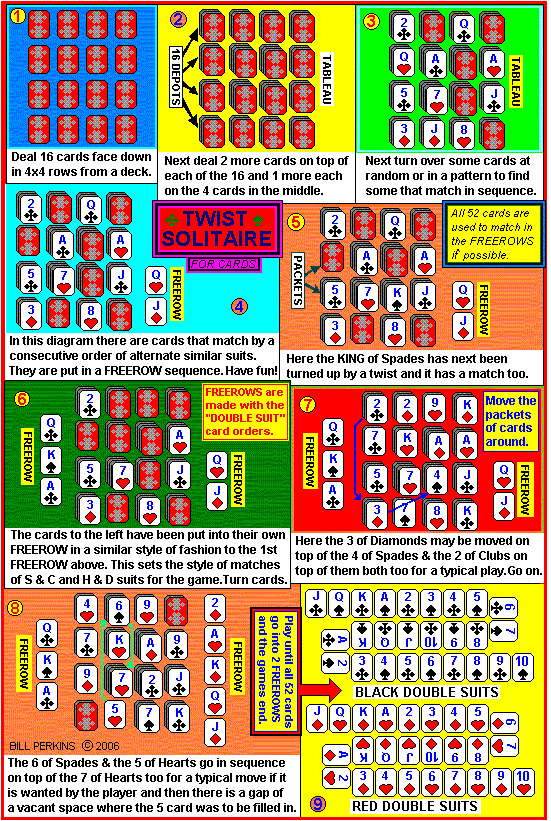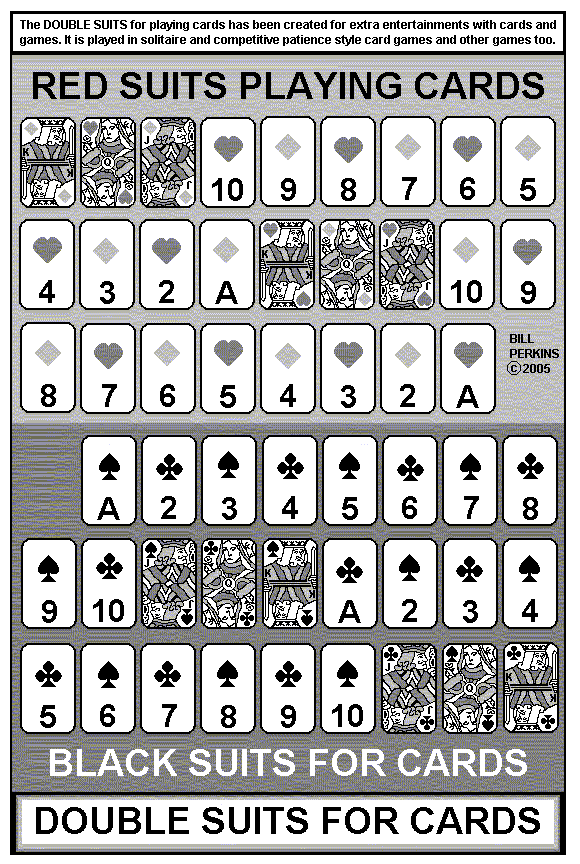Twist Solitaire
A solitaire card game by Bill Perkins
1.1) INTRODUCTION: Introduces the play of "Double Suits" to the solitaire player. An original approach to cards.
2.1) SYNOPSIS: The tableau for this game is like a big card square. It has card rows of 4x4 of cards and four "depots" of cards within each row. There are also two legs of card sequences of red or black play to perform in this solitaire game. These are the "Double Suits" for classic card playing. Two FREEROWS do figure typically in the setup on the sides of the tableau’s square of 16 depots. They are called FREEROWS because they are free to put cards in. Find all about "streaking" by winning from game to game for a game playing experience too! Red and black and back-to-back!
3.1) GETTING STARTED: AGE: 10 years and older is suggested
3.2) EQUIPMENT: one deck of 52 playing cards
3.3) DESCRIPTION: it involves novel alternating same-colored sequences in the FREEROWS and paired suits.
3.4) COMPLEXITY: it is a fairly long game; not too complex to play and not too hard to win for a challenge
* TIP: it needs a large playing surface, about three feet square. There is more. Don’t give up until it is all solved!
4.1) THE TABLEAU: Shuffle all the cards. Get ready to twist!
4.2) Next deal four ones face down in a row of the tableau. Repeat 4 times for the complete tableaus base cards layout. It is in a 4x4 square of 16 cards too. Next repeat a deal of 16 cards on all the face down cards in the tableau for another layer of cards and then do it again for 3 cards total face down on 16 piles. The four interior piles in the tableau then get a fourth card dealt to them each to finish the initial lay out. These are the 16 depots. All the cards in the game are limited to only 16 depot packets at any one time and no more as the game plays. Use the depots for further plays.
4.3) Next turn up any card in the 16-depot layout face up by a style of choice whether it is at random or by a form of some kind of a pattern. Continue with a second and more cards in progression putting the first match of two cards so matched in sequence aside in a FREEROW if you choose to. Continue with other cards and matches with turning over amounts of cards as it happens in subsequent play. This helps you to find the cards to go to the FREEROWS. Go twist!
4.4) With two FREEROWS set out on the playing surface you may continue turning cards until all 16 on top of the depots may be turned up (if it happens). These are "twists" too. Keep twisting the cards!
4.5) As sequences of cards are turned up of black and red they may be built on each other in descending sequences of amounts in a black and red order on any open card depot that matches. These built sequences may be built further with more cards as the game develops or moved from one depot to another or even split as packets and so moved too.
4.6) As cards are built in the tableau the last such card in a sequence will be an Ace and so no more cards are allowed to be built on any of them in the tableau. Play on!
5.1) OBJECT OF THE GAME: To build up or down on the starter cards by sequences of alternating suits in order of play (of the same color in each FREEROW) in complete ascending and/or descending sequences to ultimately complete the game. Any card or two cards that match may start a FREEROW. Aces and Kings typically connect as needed to continue sequences in the FREEROWS too. This takes skill. One may play two different sequences of any color/s of ones choice in the FREEROWS. Sequences must be in an order of regular numbers and faces. The tableau must be used to arrange matches on another side of related play for rest of the game too. Individual results may vary. Play for fun!
6.1) PLAYING THE GAME: You must first turn over some card/s in the tableau to get started play. Continue play.
6.2) Then start the sequences as FREEROWS by moving any appropriate cards from the tableau’s rows to the appropriate starter cards for example: 2![]() and 3
and 3![]() onto A
onto A![]() . Now you are playing with the "Double Suits" card system! NOTE: Fan out the sequences of cards laid out on the starter cards for inspection to verify that it is properly done.
. Now you are playing with the "Double Suits" card system! NOTE: Fan out the sequences of cards laid out on the starter cards for inspection to verify that it is properly done.
6.3) This does sometimes create some spaces in the reserve tableau rows that can be filled from the other depots of cards. The cards so moved to an open space might be split packets, complete packets or even face down cards too.
6.4) Typically if a depot packet has a face down set of cards another face up packet may be moved to it and placed on top of it too. Be very careful. Get very lucky too. You need to make right choices in this game! Twist on!
6.5) You may play with only one FREEROW at a time if you want. Remember that you must complete the game using two FREEROWS too. The FREEROWS are basically just long sequences with two suits of cards each. Play to them too.
6.6) Any FREEROW may have any number of limited amount of 26 possible cards at a time in play (one doesn’t necessarily contain just 13 cards in total). At the end of play of this part of game then both legs may be solved.
6.7) Remember to always join two FREEROWS of a 1st double suit when the card ends do match. This will give more options in play. For example two same colored FREEROWS may be played in the beginning of a game at one time and then joined later on so that another one may be built as the 2nd double suit sequence too. Have fun!
7.1) WINNING: It consists of running the race of the game and finishing the total card play too for a good solitaire game play. Or it may end abruptly with no possible match and a blocked effort at odds with what you may desire to achieve. What will you do to finally succeed![]() (NOTE: See illustration on other side of this page too).
(NOTE: See illustration on other side of this page too).
7.2) Example sequences in regular order: Q![]() , K
, K![]() , A
, A![]() , 2
, 2![]() , 3
, 3![]() , 4
, 4![]() , 5
, 5![]() , 6
, 6![]() , 7
, 7![]() , 8
, 8![]() , 9
, 9![]() , 10
, 10![]() , J
, J![]() , Q
, Q![]() , K
, K![]() , A
, A![]() , 2
, 2![]() , 3
, 3![]() , 4
, 4![]() , 5
, 5![]() , 6
, 6![]() , 7
, 7![]() , 8
, 8![]() , 9
, 9![]() , 10
, 10![]() , J
, J![]() & J
& J![]() , Q
, Q![]() , K
, K![]() , A
, A![]() , 2
, 2![]() , 3
, 3![]() ... etc. in similar alternating suits style. Also connect both completed sequenced FREEROWS (consisting typically of a color and two suits in each) if you choose to initially concentrate on only one side suit at a time to start with. Remember too the easy clues to play that go,"Red and black and back-to-back". The red backs its red neighbor suit just as the black backs its black neighbor suit in play. Those are the "Double Suits". Then you have both legs of all cards (2 legs of 26 cards each finished at the game’s end).
... etc. in similar alternating suits style. Also connect both completed sequenced FREEROWS (consisting typically of a color and two suits in each) if you choose to initially concentrate on only one side suit at a time to start with. Remember too the easy clues to play that go,"Red and black and back-to-back". The red backs its red neighbor suit just as the black backs its black neighbor suit in play. Those are the "Double Suits". Then you have both legs of all cards (2 legs of 26 cards each finished at the game’s end).
7.3) Play again for more fun! If you complete 2 or more such games you are streaking and on a roll with your play!
8.1) Copyright by Bill Perkins 2006.

